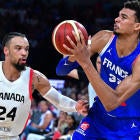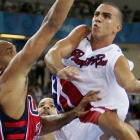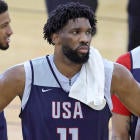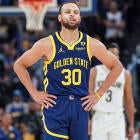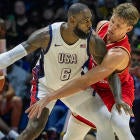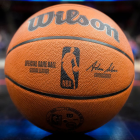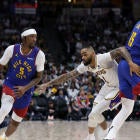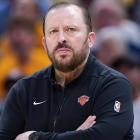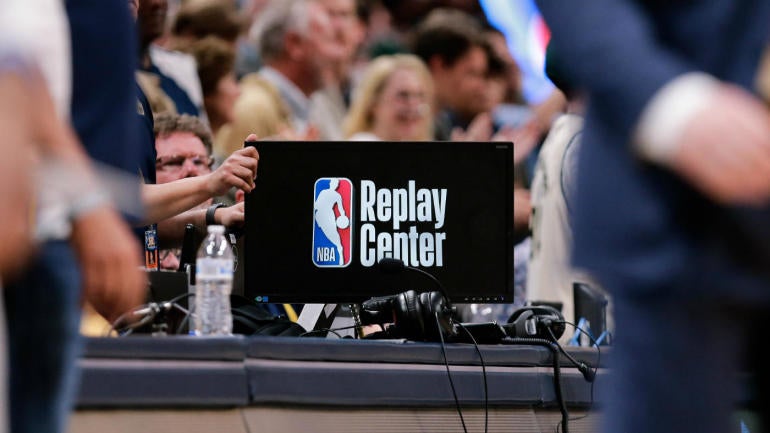
SECAUCUS, N.J. -- The bunker where the final decisions are made on all close, controversial and reviewable calls during an NBA season sits across the Lincoln Tunnel from Manhattan, a few miles west on Route 3 through the New Jersey Meadowlands, past a Best Buy and a 14-screen cinema and a Red Lobster and a Chili's, then inside a drab brown concrete building.
Walk inside, through a plaza that's equipped with two Pop-A-Shot games and a giant replica of the Larry O'Brien Trophy, past walls adorned with decades of advertisements and promotional photos featuring old NBA stars, and into the intense bunker that is the NBA Replay Center. Inside the bunker, it's more like a NASA mission control center. Television monitors wrap the entire room – 101 screens in total. On this night shortly before Christmas, the room is humming. It's 7:12 p.m. on the East Coast, just as the first of 12 NBA games this evening are tipping off. It's one of the busiest nights of the NBA regular season, so the replay center is fully staffed – 21 NBA employees in all, from the replay operators who are seated at the edges of the bunker and focusing on one game apiece, to the four NBA full-time referees who make a few rotations through the replay center each season and who are sitting on risers just behind the replay operators, to the man in the center of it all, a tall, balding former NBA referee with a goatee and a slight New York accent named Joe Borgia.
Borgia's father was legendary NBA referee Sid Borgia, so you can't say the man didn't know what he was getting into when he decided to follow his father into this thankless profession. When he gets voicemails like the one he just got from an angry fan after James Harden's travel on a stepback three went uncalled – "You're an embarrassment to the Italian heritage!" – he just shakes his head and deletes it. "The hardest thing is it's a negative profession," Borgia tells me. "People hate you automatically. What I used to tell new refs that I was training them was this: 'Don't take it personally. They don't hate you. They hate your uniform.' It's no different than cops, right?"
Borgia reffed in the CBA and the NBA for nearly two decades before an injury took him off the court and into the NBA's executive offices. As the league's senior vice president of replay and referee operations, Borgia was in charge of designing this replay center. They set up a mock replay center during the 2014 playoffs to work out kinks. (For example: Navigating the different languages between TV people and referee people. During the Finals that year, Borgia asked a guy in the TV truck in San Antonio for the angle from the overhead camera, and the guy in the TV truck sent on the feed from the Goodyear Blimp.)
Since the NBA Replay Center launched during the 2014-15 season, Borgia has spent six days a week inside the bunker as the final authority on the closest calls. He retired this offseason, but the NBA begged him to come back, so he's still flying up from his home in Florida to the New Jersey bunker to spend three or four nights a week determining if a hard foul needs to be deemed a flagrant foul, or if a clear-path foul needs to be called, or whether a made shot near the three-point line is worth two points or three, or which team gets possession on a close out-of-bounds call – that's the most difficult situation the referees regularly encounter.
"Did the ball nick a guy's finger?" Borgia says. "You have to have the perfect angle for it. Did it touch the line? You got a round ball. If you're looking from above, it's going to look different from down here. Out of bounds are really hard. You have to create a 3D picture from 2D. Two-three calls aren't hard – it's a line. But out of bounds, hands down, are the most difficult plays. You're looking at the player who was last to touch the ball. You got too focused, and you didn't see the other player had his foot on the sideline and touched it."
As Borgia is talking, there's a controlled commotion in the corner of the bunker.
"Charlotte!" a replay operator shouts out. Borgia's head, always on a swivel, shifts to that side of the room. "Close two-three! 7:16!"
This call is for a three-point shot where the shooter's foot may have been on the line. Sometimes a replay operator notices a close play and shouts it out for the NBA referee seated behind him to review. Sometimes an NBA referee on the court makes a whirly-bird signal with his finger in the middle of game action, which indicates he wants to review the most recent play during the next timeout. While the NBA Replay Center is officially used for only two or so replays per game, the referees here will review 20 or 30 close-call plays before the on-court ref ever talks with the bunker. By the time the referee on the court strides over to the courtside monitor and puts on the headset to connect to the NBA Replay Center, the refs in the bunker want to already know the answer to the ref's question.
Complain all you want about NBA referees. They are well aware that they miss calls, and they are well aware that your displeasure is part of their job. With every call they make, they know half of their audience will like the call and half of their audience will hate it: Players, coaches, fans. We focus on the major blown calls, like Kevin Durant being out of bounds in overtime against the Houston Rockets earlier this month. What you can't argue with is that, on the whole, NBA referees are remarkably accurate and consistent, and the NBA Replay Center only improves their hit rate. It's not that they're in this bunker critiquing their colleagues; it's that they're in here to assist their colleagues, taking calls that were made in real time, often while sprinting down the court, and slowing them down to half a frame at a time – increments of 1/60th of a second – looking at them from every possible angle, and making sure the right call is made.
Borgia estimates that out of the 2,200 or so calls that the NBA Replay Center consults on each year, only two or three end up incorrect in the end. Human error, he says – it happens, even in the slow-motion world of the NBA Replay Center. So far this season, 1,140 replays have been reviewed here as of Jan. 9. The two most prevalent reviews are for whether a shot is a two-pointer or a three-pointer – that accounts for more than a third of the official reviews – and for whether a shot was released before the buzzer at the end of a period, which accounts for 20 percent of reviews. The NBA Replay Center has been called on to review potential flagrant fouls 92 times so far this season; 40 of those calls have been ruled a flagrant 1 or 2 while 52 have been ruled a common foul. The average time the NBA Replay Center has taken to review a call this season is astonishingly quick: 29 seconds. The average stoppage time for a game is only 101 seconds.
'I'm trying to please the game itself'
Referees do not get into this business to make friends. It's all about being neutral, but that can be really hard in the thick of the moment, when fans and players and coaches are pushing and pulling you this way and that. Courtney Kirkland has been an NBA referee for two decades. He got into the gig by accident; he was playing college ball at Southern University in Baton Rouge, and he tore his ACL his first season. His playing career was over, but he wanted to stick around the game. The first game he refereed was an intramural game at the school's rec center. The first time he blew his whistle was when a player made a three. Kirkland's hands shot up in the air to signal the three, but he got so excited that he blew his whistle as well. Everybody stopped at stared at him: What happened? What's wrong? That was his introduction to the feeling that, the moment he put on that uniform, people looked at him in a critical way.
On this December night, Kirkland is seated in the NBA Replay Center, his eyes scanning between the two concurrent games on monitors in front of him. From inside here, without the emotional attachment that comes with being on the floor and in the heat of the moment, Kirkland can be as neutral as possible. That's not always easy when you're on the floor. I ask him what the single most important characteristic is for an NBA referee, and he has a compelling answer: "Courage."
"I'm not trying to please this fan, I'm not trying to please this player – I'm trying to please the game itself," Kirkland says. "That's the way I look at it: What is best for the game? What does the game need? That's who my friend is: The game."
I thought that the role of the NBA Replay Center would leave referees feeling a bit ambivalent. Sure, you want to get all the calls right – but do you really want a colleague remotely looking over your shoulder for 48 minutes, critiquing your every call?
That's not how these refs look at it. Not in the least. They see it as one more tool at their disposal.
"Being in the replay center is really to help them, and at the end of the day, it's to help the game," Kirkland says. "They are working their tails off trying to service the game. My role in there is to help them service the game properly. There are times when referees are in the moment, there are emotions involved. So by being in the replay center, my emotions are taken out of it. I can, from a very calm state, assist my partners that are on the floor."
'It's the worst feeling in the world'
On this night, it's a full slate, especially when games that tip at 7 p.m. Eastern coincide with games that tip at 8 p.m. Eastern. At one point, there are 10 games going on simultaneously. The referees in here can't even leave for a bathroom break during the busiest point. In Milwaukee, a ref was standing behind a shooter and couldn't tell whether his foot was on the three-point line. The ref on the floor did the whirly-bird signal, and the replay center affirmed it was a three-pointer. With 1.1 seconds left in the first quarter in a 76ers-Knicks game, Furkan Korkmaz is fouled on a made three-point shot. Borgia darts over to determine when the contact was made by the defensive player. Borgia notes when Ben Simmons is called for a technical foul in the same game.
There's a review of a two-three call in the Celtics-Suns game in Boston, then another in the Pacers-Raptors game in Toronto. With five minutes left in a blowout game between the Hornets and Cavaliers, Cavs head coach Larry Drew is given a double technical and is ejected. Not long after that, the phone in the replay center rings. It's Kiki VanDeWeghe, the NBA's executive vice president of basketball operations, and he's asking for Borgia's explanation for the ejection plus his thought on two calls on hard fouls. Borgia can't talk right now – there are two active replays going on – so he has to call VanDeWeghe back. In Milwaukee, George Hill makes a three at the third-quarter buzzer to tie the game up. They review whether he got the shot off in time. "A 60th of a second," Borgia says. "That basket is good."
The first crescendo of the night is coming. Four games are all close with less than two minutes left. Borgia's eyes focus in on the game between the Raptors and Pacers in Toronto. The Raptors had been down 12 with 10 minutes left, but a go-ahead three by Fred VanVleet followed by a couple free throws by Danny Green put the Raptors up three with 2.5 seconds left. The Pacers inbound the ball, and get it to Bojan Bogdanovic on the wing. Bogdanovic rises to shoot a three with a second left. O.G. Anunoby appears to foul him – Anunoby even had a guilty look on his face after making contact with the shooter – but the referees on the floor didn't call a foul. The buzzer sounded. Game over.
A play like that is not one of the 15 triggers that can send the call to the replay center. Seemingly every Pacer on the roster protests angrily to the refs. The voracity of players' reactions can often be an indicator that the refs missed something. And they had: It was a missed call. Borgia knows it, and so do all the referees in the replay center, but they cannot review it. As much as they try to get every call right – as much as this state-of-the-art replay center aims for a 100 percent hit rate – it's an imperfect system run by imperfect humans.
Borgia shakes his head. He knows the feeling the refs on the floor in Toronto were experiencing. Every ref knows that feeling. It's an even worse feeling because there's no check-and-balance available to their call here in Seacaucus. It's not reviewable.
"You work your ass off all night," Borgia says. "It's the worst feeling in the world. We'll admit it (in the Last Two Minute Report). And Indiana will say, 'Well, what the hell are we supposed to do now?' "










